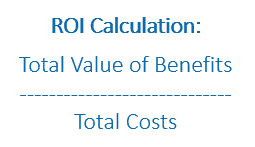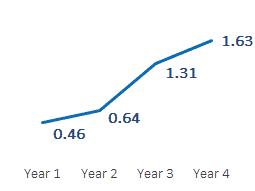The Value of Centralized Training Services
May 3rd, 2019 | viewpoint
Training providers are increasingly asked to demonstrate that training is “worth it.” In other words, is investing in a national training and technical assistance (TTA) center the best use of available resources? As competition for funding increases and there is greater demand for value, it is essential to show that national TTA centers produce benefits that exceed costs—that is, that there is a positive return on investment (ROI).
To measure the ROI of centralized TTA services, JSI compares the benefits of providing TTA with the costs of delivering it. No measure of ROI is perfect, especially when there are intangible benefits, such as the spread of skills and the creation of partnerships. That said, JSI’s method for calculating ROI is simple, economical, and research-based.[1] 
 Costs are equal to the funded amount of the TTA center. Benefits are estimated by what training participants would pay for services if they were not available for free from a TTA center. Value increases as TTA services are used. Benefits of a TTA center may include general membership that yields access to newsletters and discounts on trainings; trainings (webinars, eLearning courses, workshops, meetings, and conferences); technical assistance; and a website with information, downloadable resources, and archived training.
Costs are equal to the funded amount of the TTA center. Benefits are estimated by what training participants would pay for services if they were not available for free from a TTA center. Value increases as TTA services are used. Benefits of a TTA center may include general membership that yields access to newsletters and discounts on trainings; trainings (webinars, eLearning courses, workshops, meetings, and conferences); technical assistance; and a website with information, downloadable resources, and archived training.
Having applied this approach to several national TTA centers that JSI manages, we have found that our TTA centers consistently yield a positive ROI over time. This is largely driven by the increased demand for services as TTA centers become more established. For example, one national TTA center produced a positive ROI of 1.10 over four years. To achieve the same value produced by the TTA center, the funder would have had to invest 10% ($800K) more if training participants purchased TTA services directly. However, to achieve the same value produced by the TTA center in Year 4, the funder would have had to invest an additional 63% ($1.5M) if training participants purchased TTA services directly. Having applied this model to a few cases, our experience suggests that TTA centers need approximately two years to produce a positive ROI.
For example, one national TTA center produced a positive ROI of 1.10 over four years. To achieve the same value produced by the TTA center, the funder would have had to invest 10% ($800K) more if training participants purchased TTA services directly. However, to achieve the same value produced by the TTA center in Year 4, the funder would have had to invest an additional 63% ($1.5M) if training participants purchased TTA services directly. Having applied this model to a few cases, our experience suggests that TTA centers need approximately two years to produce a positive ROI.
Funders want to see that TTA centers are worth the investment. JSI’s ROI calculation methodology uses replacement costs for services provided. Having applied this approach to several TTA centers that JSI manages, we find that, after a ramp-up period of two years, ROI is positive and increases over time as the TTA center creates new content and demand for services increases.
[1]: Measuring the return on investment in organization development: Key issues and trends Phillips, Jack J Organization Development Journal; Winter 1998; 16, 4; ProQuest pg. 29.
Written by Katherine Quimby
We strive to build lasting relationships to produce better health outcomes for all.